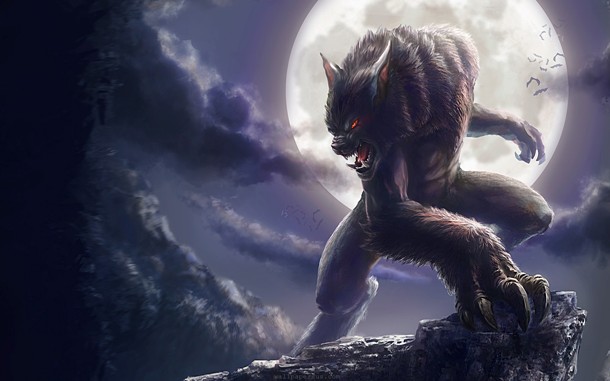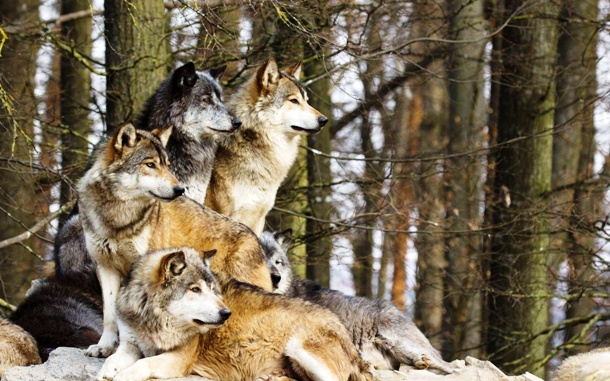24 Outrageous Werewolf Facts You Probably Never Knew!
Peter Pizagalli
Published
10/19/2014
Werewolves have been part of legends and storytelling for centuries. These giant mythological beasts craving for raw flesh are one of the most striking features of this popular horror character
- List View
- Player View
- Grid View
Advertisement
-
1.
 The word werewolf derives from Old English compound were meaning man and wulf meaning wolf.
The word werewolf derives from Old English compound were meaning man and wulf meaning wolf. -
2.
 In the 2nd century famous Greek surgeon and physician Galen of Pergamon described a health condition as clinical lycanthropy. It was a psychiatric syndrome when a patient thought he could transform into an animal.
In the 2nd century famous Greek surgeon and physician Galen of Pergamon described a health condition as clinical lycanthropy. It was a psychiatric syndrome when a patient thought he could transform into an animal. -
3.
 In fact, there is an actual medical condition referring to werewolves. Hypertrichosis, also known as the Werewolf Syndrome is a condition that causes an abnormal amount of hair growth over the body.
In fact, there is an actual medical condition referring to werewolves. Hypertrichosis, also known as the Werewolf Syndrome is a condition that causes an abnormal amount of hair growth over the body. -
4.
 The idea of werewolves became most widespread in Europe with almost every European country having its own version of this folklore mythological monster.
The idea of werewolves became most widespread in Europe with almost every European country having its own version of this folklore mythological monster. -
5.
 The werewolf concept developed simultaneously with the belief in witchcraft in Medieval times. Similarly to the witch trials, there were also werewolf trials at that time. Although the werewolf trials were not as common, they persisted as long as the early 18th century.
The werewolf concept developed simultaneously with the belief in witchcraft in Medieval times. Similarly to the witch trials, there were also werewolf trials at that time. Although the werewolf trials were not as common, they persisted as long as the early 18th century. -
6.
 According to most European legends, the werewolf could have been recognized even in his human form thanks to several physical traits such as curved fingernails or unibrow.
According to most European legends, the werewolf could have been recognized even in his human form thanks to several physical traits such as curved fingernails or unibrow. -
7.
 In Northern Europe, where the werewolf myth has been very popular, there were also legends about people transforming to other animals such as bears.
In Northern Europe, where the werewolf myth has been very popular, there were also legends about people transforming to other animals such as bears. -
8.
 The frequency of werewolf myth occurrence usually related to abundance of forests and wildlife of the particular country. Therefore, densely forested parts of Europe with abundant wild animals had more werewolf legends and stories than those in the South. But still, even countries such as Italy or Portugal have their own werewolves Lupo Manaro in Italian and Lobisomem in Portuguese language.
The frequency of werewolf myth occurrence usually related to abundance of forests and wildlife of the particular country. Therefore, densely forested parts of Europe with abundant wild animals had more werewolf legends and stories than those in the South. But still, even countries such as Italy or Portugal have their own werewolves Lupo Manaro in Italian and Lobisomem in Portuguese language. -
9.
 In countries where wolves could not be found, people came up with other mythical were-animals. Werepuma became a feared monster in South America, Weretiger in some Asian countries or Werehyena in Africa.
In countries where wolves could not be found, people came up with other mythical were-animals. Werepuma became a feared monster in South America, Weretiger in some Asian countries or Werehyena in Africa. -
10.
 It was probably through the 16th century European colonists that the werewolf legends spread to the Americas.
It was probably through the 16th century European colonists that the werewolf legends spread to the Americas. -
11.
 Not all of the mythological werewolves were evil creatures. In Latvia and Lithuania, for example, the werewolf called vilkacis was sometimes beneficial to humans, bringing them treasures. The idea of a good werewolf was also used in the popular fantasy series of Twilight movies where werewolves protect humans from evil vampires.
Not all of the mythological werewolves were evil creatures. In Latvia and Lithuania, for example, the werewolf called vilkacis was sometimes beneficial to humans, bringing them treasures. The idea of a good werewolf was also used in the popular fantasy series of Twilight movies where werewolves protect humans from evil vampires. -
12.
 The link between werewolves and vampires has been ambiguous though. While the werewolves are generally thought to compete with vampires, some Eastern European legends suggest that dead werewolves will be reborn as vampires. The Slavic word volkodlak werewolf even translates as vampire in Serbian language.
The link between werewolves and vampires has been ambiguous though. While the werewolves are generally thought to compete with vampires, some Eastern European legends suggest that dead werewolves will be reborn as vampires. The Slavic word volkodlak werewolf even translates as vampire in Serbian language. -
13.
 Similarly to the werewolf legends, in Viking Scandinavia, there were stories about the so called Ulfhednars, warriors dressed up in wolf skin, who were allegedly able to take over the spirit of the animals and use it in battles. They didnt feel any pain and killed their enemies in a frenzy-like state.
Similarly to the werewolf legends, in Viking Scandinavia, there were stories about the so called Ulfhednars, warriors dressed up in wolf skin, who were allegedly able to take over the spirit of the animals and use it in battles. They didnt feel any pain and killed their enemies in a frenzy-like state. -
14.
 The idea of werewolvery being transmittable by a bite could have originated from a disease such as rabies, which is also transmitted by a bite.
The idea of werewolvery being transmittable by a bite could have originated from a disease such as rabies, which is also transmitted by a bite. -
15.
 In 1999 in the USA, 907 people insured themselves against turning into werewolves.
In 1999 in the USA, 907 people insured themselves against turning into werewolves. -
16.
 The appearance of the werewolf in his animal form varied significantly with regions but there were several typical attributes common to most of them. The werewolf was usually larger than a regular wolf, kept human voice and eyes, was able to walk on his hind legs and ate freshly buried human remains.
The appearance of the werewolf in his animal form varied significantly with regions but there were several typical attributes common to most of them. The werewolf was usually larger than a regular wolf, kept human voice and eyes, was able to walk on his hind legs and ate freshly buried human remains. -
17.
 Werewolves are thought to have supernatural healing abilities and are known to be immune to damage caused by ordinary human weapons. The only thing supposed to hurt them is a silver object, primarily a silver bullet. It might have been inspired by the Beast of Gevaudan that was allegedly killed with a silver consecrated bullet.
Werewolves are thought to have supernatural healing abilities and are known to be immune to damage caused by ordinary human weapons. The only thing supposed to hurt them is a silver object, primarily a silver bullet. It might have been inspired by the Beast of Gevaudan that was allegedly killed with a silver consecrated bullet. -
18.
 Although wolf attacks on humans are very rare nowadays, there have been several cases of man-eating wolf packs. One of the scariest happened in 1996 when a pack of wolves repeatedly attacked villages in Uttar Pradesh, India. The hungry wolves focused mainly on young children and they actually succeed in seizing and eating a few of them. Scared by the brutal attacks, the locals then believed it was werewolves who killed the children.
Although wolf attacks on humans are very rare nowadays, there have been several cases of man-eating wolf packs. One of the scariest happened in 1996 when a pack of wolves repeatedly attacked villages in Uttar Pradesh, India. The hungry wolves focused mainly on young children and they actually succeed in seizing and eating a few of them. Scared by the brutal attacks, the locals then believed it was werewolves who killed the children. -
19.
 Thanks to their fearsome reputation, werewolves became popular in Gothic horror genre at the beginning of the 19th century and their popularity was on increase, leading up to the first mainstream werewolf film, 1935's Werewolf of London.
Thanks to their fearsome reputation, werewolves became popular in Gothic horror genre at the beginning of the 19th century and their popularity was on increase, leading up to the first mainstream werewolf film, 1935's Werewolf of London. -
20.
 Fascinated with occultism and old German mythology, Adolf Hitler used the word Werwolf German spelling of Werewolf as a codename for one of his headquarters in the WWII.
Fascinated with occultism and old German mythology, Adolf Hitler used the word Werwolf German spelling of Werewolf as a codename for one of his headquarters in the WWII. -
21.
 There were many guaranteed ways of becoming a werewolf. The most common were: inherit the werewolvery from parents, get bitten by a werewolf, get cursed by a gypsy, put on a wolf-skin belt, drink water out of a werewolfs footprint, or sleep outside with a full moon shining on the persons face.
There were many guaranteed ways of becoming a werewolf. The most common were: inherit the werewolvery from parents, get bitten by a werewolf, get cursed by a gypsy, put on a wolf-skin belt, drink water out of a werewolfs footprint, or sleep outside with a full moon shining on the persons face. -
22.
 Removing the werewolvery could have been achieved by several methods ranging from exorcism and a medical approach using Aconitum, a flowering plant, to more extreme techniques such as piercing the werewolfs hands with nails.
Removing the werewolvery could have been achieved by several methods ranging from exorcism and a medical approach using Aconitum, a flowering plant, to more extreme techniques such as piercing the werewolfs hands with nails. -
23.
 One of the most popular real stories based on the werewolf idea was the one of the Beast of Gevaudan. Between 1764 and 1767, the Gevaudan province in south-central France was terrorized by an unspecified wolf-like creature. Allegedly, the beast attacked over 200 humans, killing and eating about 100 of them. At that time, people thought it to be a werewolf but modern theories suggest it was a huge domestic dog or a dog-wolf hybrid.
One of the most popular real stories based on the werewolf idea was the one of the Beast of Gevaudan. Between 1764 and 1767, the Gevaudan province in south-central France was terrorized by an unspecified wolf-like creature. Allegedly, the beast attacked over 200 humans, killing and eating about 100 of them. At that time, people thought it to be a werewolf but modern theories suggest it was a huge domestic dog or a dog-wolf hybrid. -
24.
 Werewolves didnt always have to be males. In Armenia, people believed if a woman was convicted of a deadly sin, she had to transform into a wolf and spend seven years in this state.
Werewolves didnt always have to be males. In Armenia, people believed if a woman was convicted of a deadly sin, she had to transform into a wolf and spend seven years in this state.









3 Comments